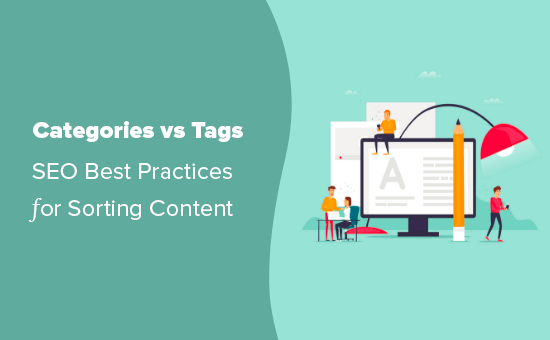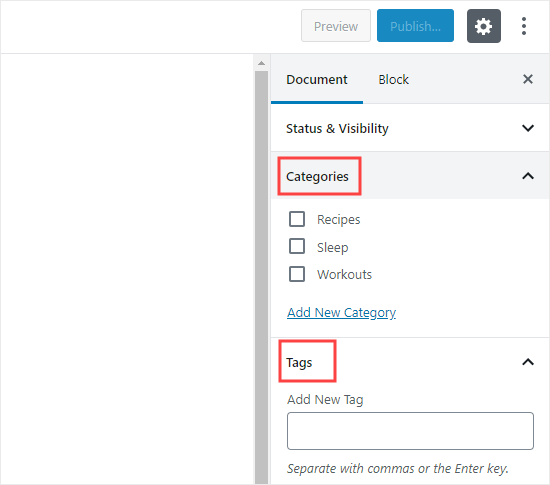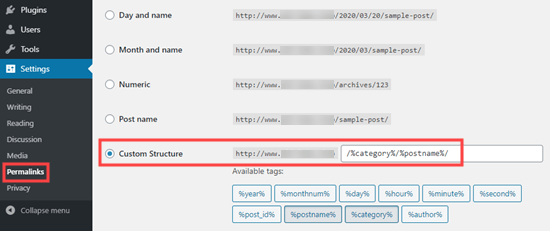Get best WooCommerce Plugins > Instagram stands out among tons of social media platforms as…
Categories vs Tags – SEO Best Practices for Sorting your Content

Readers often ask us, what’s better for SEO: categories vs tags?
You might not be sure what WordPress categories and tags actually are, and how they’re different. Knowing this can help you use them correctly.
In this article, we’ll explain the differences between categories vs tags for organizing your content, and how they can impact SEO rankings.
What’s the Difference Between Categories and Tags?
Categories are meant for broad grouping of your posts. Think of these as general topics or the table of contents for your WordPress site. Categories are hierarchical which means you can create sub-categories.
Tags are meant to describe specific details of your posts. Think of these as your site’s index words. They let you micro-categorize your content. Tags are not hierarchical.
For example, this blog post on WHOOPS.ONLINE is in our category “Beginners Guide”. You can see all the posts in this category by going to Blog » Beginners Guide in our navigation menu.
This post has the tags: categories, categories vs tags, custom taxonomy, seo, seo best practices, sorting your content, and tags.
You won’t see these tags displaying anywhere on our article. However, they do help users find this article in relevant searches on our blog.
One of the biggest differences between tags and categories is that all WordPress posts must be filed under a category, but they don’t have to have tags.
If you don’t give your post a category, WordPress will automatically assign it to the default category. This is called “Uncategorized”, but it’s often helpful to rename the “uncategorized” category to something like “Other” or “Miscellaneous”.
Note: By default, only blog posts have categories and tags in WordPress. However, you can add categories and tags to your WordPress pages using a plugin.
How can You Add Categories and Tags in WordPress?
You can add categories and tags in WordPress when creating or editing a post. You’ll find them on the right-hand side under the ‘Document’ settings.

You can also go to Posts » Categories and Posts » Tags to add new categories and tags.
For more about the process of adding categories and tags, check out our explanations of What is a category? and What is a tag? for help and guidance.
How Many WordPress Categories Should You Have?
There’s no specific number of categories that you should have. In most cases, you’ll want somewhere between 5 and 10 in order to properly categorize your posts and make your site easy to browse.
Categories are meant to encompass a large group of posts. You can use sub-categories and tags to split your posts into smaller groups.
If you’re just starting a blog, then don’t worry about trying to come up with a perfect list of categories. Just choose 3 – 5 broad categories and add more as time goes by.
Do I have to use sub-categories?
You don’t have to use sub-categories, and many large blogs (including WHOOPS.ONLINE) don’t. However, sub-categories are helpful if you have a large category with a lot of posts that could be grouped into smaller sections.
For example, you might have a “Recipes” category that contains a growing number of gluten-free recipes.

You can put these posts into their own sub-category, so it’s easy for readers to find them. You create a new child category for “Recipes” called “Gluten-Free” and move these posts into that category.
Using Categories in Your Posts’ URLs
Some sites use the Category name in permalinks (post URLs), which you can set up under Settings » Permalinks.

If that’s the case on your site, then your post will initially have a URL something like this:
…/recipes/gluten-free-pancakes/
After moving the post to a child category, it’ll have a new URL:
…/recipes/gluten-free/gluten-free-pancakes/
Normally, WordPress will try to redirect the old URL to the new one. It’s definitely worth checking that your links are still working. If necessary, you can create a 301 redirect from the old URL to the new one.
Another option is to keep the post in the parent category as well as assigning it to the child category, but this can have drawbacks.
Although, WHOOPS.ONLINE website has categories in the URL, we always recommend users to use shorter URL structure that only contains “Post name”.
This will give you maximum flexibility to reorganize content without worrying about setting up redirects.
All of our new websites use the modern Post name URL structure. WHOOPS.ONLINE is over 10 years old, so it has legacy URL structure and changing URL structure is not recommended for SEO which is why we have stuck with it.
Can I Assign One Post to Multiple Categories?
WordPress lets you put a post into multiple categories. This could be several parent categories, or a parent category plus a subcategory or subcategories.
Having multiple categories won’t benefit your SEO. You should only assign posts to multiple categories if it makes the most sense for your readers.
It’s possible that having your post in multiple categories could cause some SEO issues due to duplicate content.
If you do use multiple categories, then try to avoid putting one post into two or more main (parent) categories. Each post should fit within one main category.
Is There a Limit to How Many Tags a Post Can Have?
WordPress itself doesn’t have any limit on the number of tags you can have on each post. You could potentially assign 1,000 or more tags to a post!
However, we definitely don’t recommend that.
The purpose of tags is to help link related posts together. Think of them as an index section in a book. Each tag is like a keyword in the index.
Tags are helpful for users searching your site. Some plugins that display related posts use tags to help them figure out which posts’ topics are related.
We suggest that you normally stick to 10 tags maximum per post.
Categories vs Tags: What’s Better for SEO?
Are there any WordPress SEO advantages of using categories over tags or vice versa?
The short answer is No.
Categories and tags both have different purposes. You have to use categories, but you don’t have to use tags if you don’t want to. However, we recommend using both, appropriately, to help readers navigate your site.
Ultimately, you should design your site with users in mind. All search engines want to show users the content that’ll be the most useful to them.
This means that by organizing your content for best usability will also help you get better SEO rankings.
We hope that this article helped you understand categories vs tags and the SEO best practices for sorting your content. You may also like our article on how to track WordPress category and tag analytics, and our comparison of the best keyword research tools for SEO.
- Sale
Connect 365/7/24 Hourly Support
Original price was: $120.00.$99.00Current price is: $99.00. - Sale
Connect Auto-Pilot for WordPress Content Management
Original price was: $599.00.$499.00Current price is: $499.00. - Sale
%22%20transform%3D%22translate(1.8%201.8)%20scale(3.63281)%22%20fill-opacity%3D%22.5%22%3E%3Cpath%20fill%3D%22%23c2ffee%22%20d%3D%22M204.4%20130.6l1.2%2072-158%202.8-1.2-72z%22%2F%3E%3Cellipse%20fill%3D%22%23c4ffef%22%20cx%3D%22122%22%20cy%3D%2272%22%20rx%3D%2283%22%20ry%3D%2235%22%2F%3E%3Cellipse%20fill%3D%22%23beffea%22%20cx%3D%2265%22%20cy%3D%22126%22%20rx%3D%2235%22%20ry%3D%2256%22%2F%3E%3Cellipse%20fill%3D%22%2388ccb5%22%20rx%3D%221%22%20ry%3D%221%22%20transform%3D%22matrix(51.92988%20-137.38378%2059.61857%2022.5353%20255%20209.3)%22%2F%3E%3C%2Fg%3E%3C%2Fsvg%3E) Select options This product has multiple variants. The options may be chosen on the product page
Select options This product has multiple variants. The options may be chosen on the product pageConnect WordPress Maintenance Plans
$99.00 – $224.00






